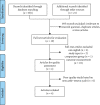Risk of Uterine Rupture with Vaginal Birth after Cesarean in Twin Gestations
- PMID: 33868405
- PMCID: PMC8032534
- DOI: 10.1155/2021/6693142
Risk of Uterine Rupture with Vaginal Birth after Cesarean in Twin Gestations
Abstract
Background: Women with a previous cesarean delivery may attempt a subsequent vaginal birth or repeat cesarean. Vaginal birth after cesarean carries a greater risk of uterine rupture, defined as the disruption of all uterine layers, resulting in maternal-fetal morbidity or mortality. It is unclear how the risk of uterine rupture compares in patients with twin gestations who undergo different delivery methods.
Objective: The purpose of this systematic review is to determine if there is an increased risk of uterine rupture in patients with twin gestations attempting vaginal birth after cesarean (VBAC) versus planned repeat cesarean delivery (PRCD). Study Design. PubMed, Cochrane Library, and CINAHL were searched systematically. Eligible studies were prospective and retrospective studies that evaluated the incidence of uterine rupture in twin pregnancies that attempted VBAC or PRCD. Data were manually extracted from these studies, and the number of events in each group was used to calculate an odds ratio (OR) and 95% confidence interval (CI).
Results: 4 retrospective studies were included with a total of 7699 participants, 2305 of whom attempted VBAC and 5394 underwent PRCD. The absolute risk of uterine rupture in the VBAC and PRCD groups was 0.87% and 0.09%, respectively. The rate of uterine rupture was significantly higher in the VBAC group than in the PRCD group (OR: 9.43; CI: 3.54-25.17).
Conclusion: Although VBAC is associated with higher rates of uterine rupture in twin pregnancies when compared with PRCD, the absolute risk of uterine rupture is low in both groups. Depending on individual risk factors, vaginal birth may be offered as a safe option to women with twin pregnancies and a history of cesarean delivery.
Copyright © 2021 Kimya Baradaran.
Conflict of interest statement
The author declares that there are no conflicts of interest regarding the publication of this article.
Similar articles
-
Trial of labor after cesarean delivery in twin gestations: systematic review and meta-analysis.Am J Obstet Gynecol. 2019 Apr;220(4):336-347. doi: 10.1016/j.ajog.2018.11.125. Epub 2018 Nov 19. Am J Obstet Gynecol. 2019. PMID: 30465748
-
Vaginal birth after cesarean (VBAC) attempt in twin pregnancies: is it safe?Am J Obstet Gynecol. 2005 Sep;193(3 Pt 2):1050-5. doi: 10.1016/j.ajog.2005.06.038. Am J Obstet Gynecol. 2005. PMID: 16157110
-
Failed vaginal birth after a cesarean section: how risky is it? I. Maternal morbidity.Am J Obstet Gynecol. 2001 Jun;184(7):1365-71; discussion 1371-3. doi: 10.1067/mob.2001.115044. Am J Obstet Gynecol. 2001. PMID: 11408854
-
Delivery for women with a previous cesarean: guidelines for clinical practice from the French College of Gynecologists and Obstetricians (CNGOF).Eur J Obstet Gynecol Reprod Biol. 2013 Sep;170(1):25-32. doi: 10.1016/j.ejogrb.2013.05.015. Epub 2013 Jun 28. Eur J Obstet Gynecol Reprod Biol. 2013. PMID: 23810846 Review.
-
The effect of prematurity on vaginal birth after cesarean delivery: success and maternal morbidity.Obstet Gynecol. 2005 Mar;105(3):519-24. doi: 10.1097/01.AOG.0000153493.15922.85. Obstet Gynecol. 2005. PMID: 15738018
Cited by
-
Unexpected Uterine Rupture-A Case Report, Review of the Literature and Clinical Suggestions.J Clin Med. 2023 May 18;12(10):3532. doi: 10.3390/jcm12103532. J Clin Med. 2023. PMID: 37240638 Free PMC article.
-
Neglected medium-term and long-term consequences of labour and childbirth: a systematic analysis of the burden, recommended practices, and a way forward.Lancet Glob Health. 2024 Feb;12(2):e317-e330. doi: 10.1016/S2214-109X(23)00454-0. Epub 2023 Dec 6. Lancet Glob Health. 2024. PMID: 38070535 Free PMC article. Review.
-
Comparison of Clinical and Radiological Findings for the Prediction of Scar Integrity in Women With Previous Lower Segment Cesarean Sections.Cureus. 2023 Aug 23;15(8):e43976. doi: 10.7759/cureus.43976. eCollection 2023 Aug. Cureus. 2023. PMID: 37746359 Free PMC article.
-
Factors Associated with Failed Trial of Labor after Cesarean, among Women with Twin Gestation-A Multicenter Retrospective Cohort Study.J Clin Med. 2022 Jul 22;11(15):4256. doi: 10.3390/jcm11154256. J Clin Med. 2022. PMID: 35893349 Free PMC article.
-
Intrapartum ultrasound measurement of the lower uterine segment thickness in parturients with previous scar in labor: a cross-sectional study.BMC Pregnancy Childbirth. 2022 May 14;22(1):409. doi: 10.1186/s12884-022-04747-3. BMC Pregnancy Childbirth. 2022. PMID: 35568830 Free PMC article.
References
-
- Placek P. J., Taffel S. M. Trends in cesarean section rates for the United States, 1970-78. Obstetrical & Gynecological Survey. 1981;36(8):433–434. doi: 10.1097/00006254-198108000-00011. - DOI
-
- Martin J. A., Hamilton B. E., Osterman M. J. K., Driscoll A. K., Drake P. Births: final data for 2016. National Vital Statistics Report. 2018;67(1):p. 7. - PubMed
LinkOut - more resources
Full Text Sources
Other Literature Sources


